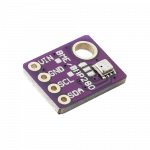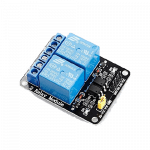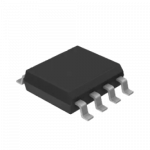System Overview
Inamata IoT Platform
This platform allows engineers to quickly create their own IoT (Internet-of-Things) systems. It provides an open source firmware that is flashed on ESP32 microchips. This allows peripherals to be configured by the accompanying web app.
Graphically programmed control plans allow commanding a fleet of microchips and dashboards make monitoring your real-world systems easy.
Follow our startup guides to get your own IoT system up in a matter of minutes. If you run into problems, our forums are the quickest way to get support from our team.
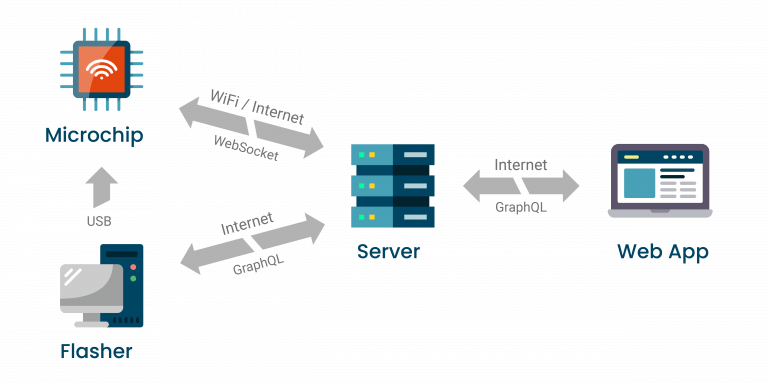
WiFi-Capable Microchips
Enable Sensing and Interacting with the World
Microchips based on the ESP32 family make up the basis of the Inamata IoT platform. They are flashed with a custom open-source firmware. This allows peripherals to be configured from the web-app and tasks to be run on them. Peripherals such as air and power sensors can send data to the server. Alternatively, attached relays can be used to command motors and lights.
The Inamata IoT platform allows pushing OTA updates to the microchips which ensures bugs can be fixed in deployments and new functionality delivered. Meanwhile, the TLS encryption keeps the connection to the server secure. In addition, capability-based tasks allow users to add their own custom peripherals which increases the platform’s flexibility.
The firmware can be reviewed and customized on its GitHub page.
Sensors & Actuators
ESP32 is a family of inexpensive WiFi-capable microchips. They are produced by Espressif and have been integrated into a range of devices, from smart plugs to industrial shields.
- Digital In
- Digital Out
- Analog In
- Analog Out
- PWM
- I2C
- One-Wire
- Serial
- SPI
- CAN
- Read out sensors
- Control actuators
- Calibrate sensors
- Threshold triggers
- PID controlling
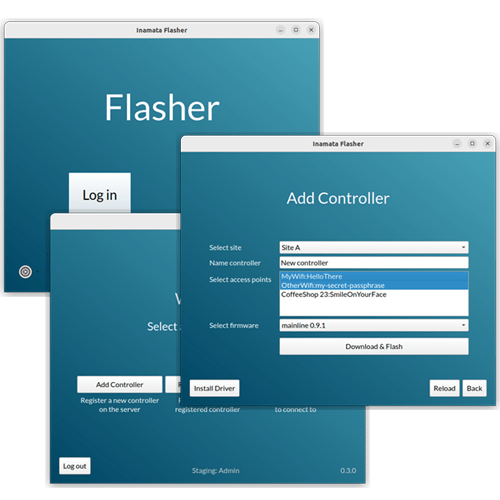
- Flash Microchip
- Register with server
- Multi-WiFi support
- Replace registration
- Installer & standalone
- Configure WiFi
- Select name & site
- Select firmware
- Add TLS certificate
- Download & flash
- Windows
- Linux
- Open Source
Easy Microchip Setup with the Windows & Linux Flasher App
To avoid the tedious setup of the microchips, especially when many are involved, the Flasher app allows easy registration with the server. It flashes microchips with the latest firmware, configures your local WiFi connections and allows you to name them. Permission setup with site selection is also supported.
The app runs on Windows and Linux and is distributed as a Windows installer, an Ubuntu Snap package and a portable executable as well as being open source. For older versions and other packages see the GitHub releases page.
Configure, Command and Monitor Your Microchip Fleet from the Web App
The web app provided by the Inamata IoT platform allows microchips to be configured from your browser. This avoids having to write custom C code, dealing with firmware configurations and creating server-microchip communication protocols. The configured microchips can then be commanded to sense and interact with the world around them.
The web app’s control plans allows you to orchestrate a fleet of microchips to interact together. This allows pumps to be started, water levels to be measured and decisions to be made depending on the incoming data. The control plans themselves can be monitored to debug problems and help with their graphical programming.
In addition, dashboards can be created to view the sensed data in real-time. This allows you to keep an eye on your systems in the real world. Quick commands can also be sent to perform common actions or act as fail-safes.

WiFI capacle inexpensive from 2,50 € produced by Espressif
- Digital In
- Digital Out
- Analog In
- Analog Out
- PWM
- I2C
- One-Wire
- Serial
- SPI
- CAN
- Read out sensors
- Control actuators
- Calibrate sensors
- Threshold triggers
- PID controlling


